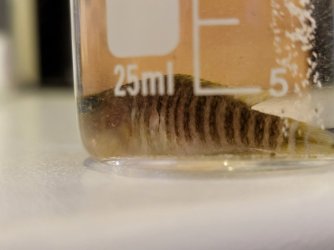Hi,
I added some shell dwellers to my trio two weeks ago. I noticed one of them behaving strangely. He mostly sits in the sand or on top of his shell, and he looks a bit bloated. However, he was eating well and he had been in the LFS for a long time, so I didn't pay much attention to him. Today, I saw a hole on the right side of his body, and the other side still looks bloated. I can clearly see a bump on the left side.
My question is: I think he has hole-in-the-head disease (even if it's not on the head, or maybe something else? Pics attached) and he had it before coming to my tank. The others are all doing great and I isolated the sick one. Are the others at risk of contracting it? Do I need to treat the tank? (I hope not)
My water is pretty clean, i use RO water (0TDS) with seachem tanganyika buffer and seachem cichlid lake salt to remeneralize the water. Nitrates under 10ppm, no phosphates, activated cardon, and an air pump to keep water oxygenated and Ph up. I feed good quality dry foods and 3 to 4 times a week frozen (artemias with spirulina and garlic oil, bloodworms, lobster eggs etc etc) and live (brine shrimps) foods.
Thanks
I added some shell dwellers to my trio two weeks ago. I noticed one of them behaving strangely. He mostly sits in the sand or on top of his shell, and he looks a bit bloated. However, he was eating well and he had been in the LFS for a long time, so I didn't pay much attention to him. Today, I saw a hole on the right side of his body, and the other side still looks bloated. I can clearly see a bump on the left side.
My question is: I think he has hole-in-the-head disease (even if it's not on the head, or maybe something else? Pics attached) and he had it before coming to my tank. The others are all doing great and I isolated the sick one. Are the others at risk of contracting it? Do I need to treat the tank? (I hope not)
My water is pretty clean, i use RO water (0TDS) with seachem tanganyika buffer and seachem cichlid lake salt to remeneralize the water. Nitrates under 10ppm, no phosphates, activated cardon, and an air pump to keep water oxygenated and Ph up. I feed good quality dry foods and 3 to 4 times a week frozen (artemias with spirulina and garlic oil, bloodworms, lobster eggs etc etc) and live (brine shrimps) foods.
Thanks
Attachments
Last edited:




